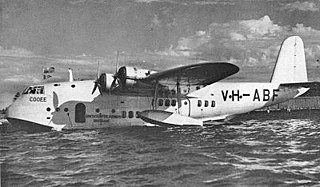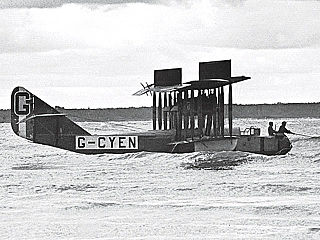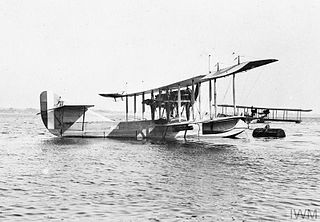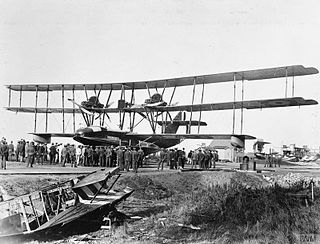
A flying boat is a type of fixed-winged seaplane with a hull, allowing it to land on water. It differs from a floatplane in having a fuselage that is purpose-designed for flotation, while floatplanes rely on fuselage-mounted floats for buoyancy.

A seaplane is a powered fixed-wing aircraft capable of taking off and landing (alighting) on water. Seaplanes are usually divided into two categories based on their technological characteristics: floatplanes and flying boats; the latter are generally far larger and can carry far more. Seaplanes that can also take off and land on airfields are in a subclass called amphibious aircraft, or amphibians. Seaplanes were sometimes called hydroplanes, but currently this term applies instead to motor-powered watercraft that use the technique of hydrodynamic lift to skim the surface of water when running at speed.

The Royal Naval Air Service (RNAS) was the air arm of the Royal Navy, under the direction of the Admiralty's Air Department, and existed formally from 1 July 1914 to 1 April 1918, when it was merged with the British Army's Royal Flying Corps to form the Royal Air Force (RAF), the world's first independent air force.

Air Marshal Robert Leckie, was an air officer in the Royal Air Force and later in the Royal Canadian Air Force, and served as Chief of the Air Staff of the Royal Canadian Air Force from 1944 to 1947. He initially served in the Royal Naval Air Service during the First World War, where he became known as one of "the Zeppelin killers from Canada", after shooting down two airships. During the inter-war period he served as a Royal Air Force squadron and station commander, eventually becoming the RAF's Director of Training in 1935, and was Air Officer Commanding RAF Mediterranean from 1938 until after the beginning of the Second World War. In 1940 he returned to Canada where he was primarily responsible for the British Commonwealth Air Training Plan, transferring to the Royal Canadian Air Force in 1942.

Air Commodore Charles Rumney Samson, was a British naval aviation pioneer. He was one of the first four officers selected for pilot training by the Royal Navy and was the first person to fly an aircraft from a moving ship. He also commanded the first British armoured vehicles used in combat. Transferring to the Royal Air Force on its creation in 1918, Samson held command of several groups in the immediate post-war period and the 1920s.
RNAS Calshot was a First World War Royal Navy air station for seaplanes and flying boats, mainly operating as an experimental and training station, but also providing anti-submarine and convoy protection patrols.

The Felixstowe F.2 was a 1917 British flying boat class designed and developed by Lieutenant Commander John Cyril Porte RN at the naval air station, Felixstowe during the First World War adapting a larger version of his superior Felixstowe F.1 hull design married with the larger Curtiss H-12 flying boat. The Felixstowe hull had superior water contacting attributes and became a key base technology in most seaplane designs thereafter.

The Felixstowe Porte Baby was a British reconnaissance flying boat of the First World War, first flying in 1915.

The Felixstowe F.5 was a British First World War flying boat designed by Lieutenant Commander John Cyril Porte RN of the Seaplane Experimental Station, Felixstowe.

The Felixstowe F.3 was a British First World War flying boat, successor to the Felixstowe F.2 designed by Lieutenant Commander John Cyril Porte RN at the naval air station, Felixstowe.

Lieutenant Colonel John Cyril Porte, was a British flying boat pioneer associated with the First World War Seaplane Experimental Station at Felixstowe.

The Curtiss Model H was a family of classes of early long-range flying boats, the first two of which were developed directly on commission in the United States in response to the £10,000 prize challenge issued in 1913 by the London newspaper, the Daily Mail, for the first non-stop aerial crossing of the Atlantic. As the first aircraft having transatlantic range and cargo-carrying capacity, it became the grandfather development leading to early international commercial air travel, and by extension, to the modern world of commercial aviation. The last widely produced class, the Model H-12, was retrospectively designated Model 6 by Curtiss' company in the 1930s, and various classes have variants with suffixed letters indicating differences.

Group Captain Gerald Edward Livock was an English officer of the Royal Naval Air Service and Royal Air Force, who served from the beginning the First World War until the end of Second, and was also an archaeologist and cricketer. A right-handed batsman and wicket-keeper, he played first-class cricket for various teams between 1923 and 1934.

The Felixstowe F.4 Fury, also known as the Porte Super-Baby, was a large British, five-engined triplane flying-boat designed by John Cyril Porte at the Seaplane Experimental Station, Felixstowe, inspired by the Wanamaker Triplane/Curtiss Model T. At the time the Fury was the largest seaplane in the world, the largest British aircraft, and the first aircraft controlled successfully by servo-assisted means.

The Felixstowe F.1 was a British experimental flying boat designed and developed by Lieutenant Commander John Cyril Porte RN at the naval air station, Felixstowe based on the Curtiss H-4 with a new hull. Its design led to a range of successful larger flying boats that was assistance in promoting Britain as a leader in this field of aviation.
RAF Coastal Area was a formation within the Royal Air Force (RAF). Founded in 1919, it was to act as the RAF's premier maritime arm. It was replaced by RAF Coastal Command on 14 July 1936.

The Wanamaker Triplane or Curtiss Model T, retroactively renamed Curtiss Model 3 was a large experimental four-engined triplane patrol flying boat of World War I. It was the first four-engined aircraft built in the United States. Only a single example (No.3073) was completed. At the time, the Triplane was the largest seaplane in the world.
RNAS Tresco was a Royal Naval Air Service base on Tresco, the second largest island in the Isles of Scilly. From February 1917 to May 1919 aircraft patrolled the Western Approaches and provided an escort for convoys. A total of thirteen U-boats were sighted and nine attacked.

Royal Air Force Felixstowe or more simply RAF Felixstowe is a former Royal Air Force station located 2.7 miles (4.3 km) northeast of Harwich, Essex, England and 10.7 miles (17.2 km) southeast of Ipswich, Suffolk.
RAF Catfirth was a First World War seaplane base located on the island of Mainland in the Shetland Islands, Scotland. The base was under the control of the Royal Naval Air Service (RNAS), and later Royal Air Force (RAF)
















